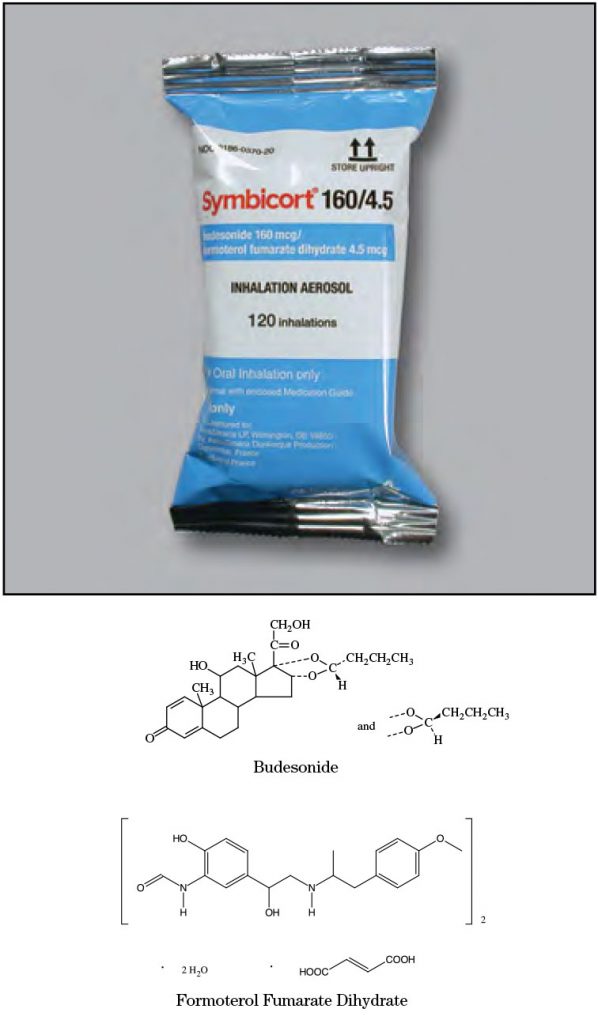
byū/des’ō/nīd fōr/mō’te/rol fyū’mar/āt
Brand Names: Symbicort®
Common Dosage Forms:
- Metered Dose Inhaler (80/4.5): Each actuation contains budesonide 80 mcg and formoterol fumarate dihydrate 4.5 mcg.
- Metered Dose Inhaler (160/4.5): Each actuation contains budesonide 160 mcg and formoterol fumarate dihydrate 4.5 mcg.
FDA Indications/Dosages:
- For the treatment of asthma in patients 12 years of age and older: 2 inhalations twice daily (80/4.5 or 160/4.5 metered dose inhaler).
- For the maintenance treatment of airflow obstruction in patients with chronic obstructive pulmonary disease (COPD) including chronic bronchitis and emphysema: 2 inhalations twice daily (160/4.5 metered dose inhaler).
Monitor:
BMD, IOP, FEV
Pharmacology/Pharmacokinetics:
Budesonide in a potent anti-inflammatory corticosteroid which shows inhibitory activities against multiple cell types (eg, mast cells, eosinophils, neutrophils, macrophages, and lymphocytes) and mediators (eg, histamine, eicosanoids, leukotrienes, and cytokines). Formoterol is a long-acting selective beta-2-adrenergic agonist which acts locally in the lung as a bronchodilator. Formoterol, through stimulation of adenyl cyclase, relaxes smooth muscle and inhibits the release of mast cell mediators such as histamine and leukotrienes. Budesonide is extensively metabolized primarily via CYP3A4 to inactive ingredients. Formoterol is metabolized via CYP2D6 and CYP2C.
Drug Interactions:
Additive effects occur with systemic corticosteroids. Other sympathomimetics, tricyclic antidepressants, and monoamine oxidase inhibitors may increase the toxicity of this medication. Beta-blockers may decrease the effectiveness of formoterol. Strong CYP3A4 inhibitors (ritonavir, atazanavir, clarithromycin, indinavir, itraconazole, nefazodone, nelfinavir, saquinavir, keconazole, telithromycin) may increase plasma levels.
Contraindications/Precautions:
Use is contraindicated in the primary treatment of status asthmaticus. LONG-ACTING BETA-2-ADRENERGIC AGONISTS INCREASE THE RISK OF ASTHMARELATED DEATH. Use caution in patients who are being transferred from systemic corticosteroids because deaths due to adrenal insufficiency have occurred during and after transfer to aerosolized steroids. Systemic steroids should be administered to these patients during periods of stress or during an acute asthmatic attack. This medication is not to be regarded as a bronchodilator and should not be given for rapid relief of bronchspasm. Secondary fungal infections of the oral cavity may occur and may require antifungal treatment. Response of the hypothalamic-pituitary-adrenal (HPA) function is highly individualized. Use caution in patients with cardiovascular disorders, hypertension, hyperthyroidism, diabetes mellitus, in nursing mothers or during pregnancy. Pregnancy Category C.
Adverse Effects:
Adverse effects are usually mild to moderate in severity and include upper respiratory tract infection, nasopharyngitis, headache, vomiting, sinusitis, bronchitis, oral candidiasis, and nasal congestion.
Patient Consultation:
- Avoid contact with the eyes. • Rinse mouth after each use.
- Contact a physician if the above side effects are severe or persistent.
- Contact a physician if symptoms worsen or if the effectiveness of short-acting beta-2-agonists decreases.
- If a dose is missed, skip it and return to normal dosing schedule.
- Not intended to provide immediate relief of bronchospasm.
- To receive the full benefits of therapy, use on a regular basis. Although benefits can be seen after 2 days of treatment, up to four weeks may be needed to observe benefits.
- It is important that the patient understands how to use the metered dose inhaler appropriately.